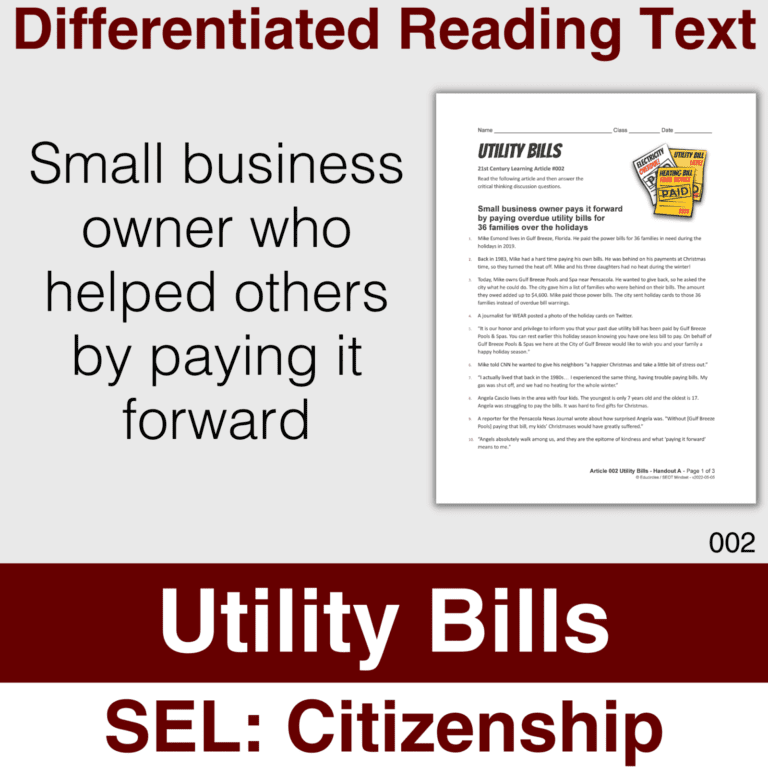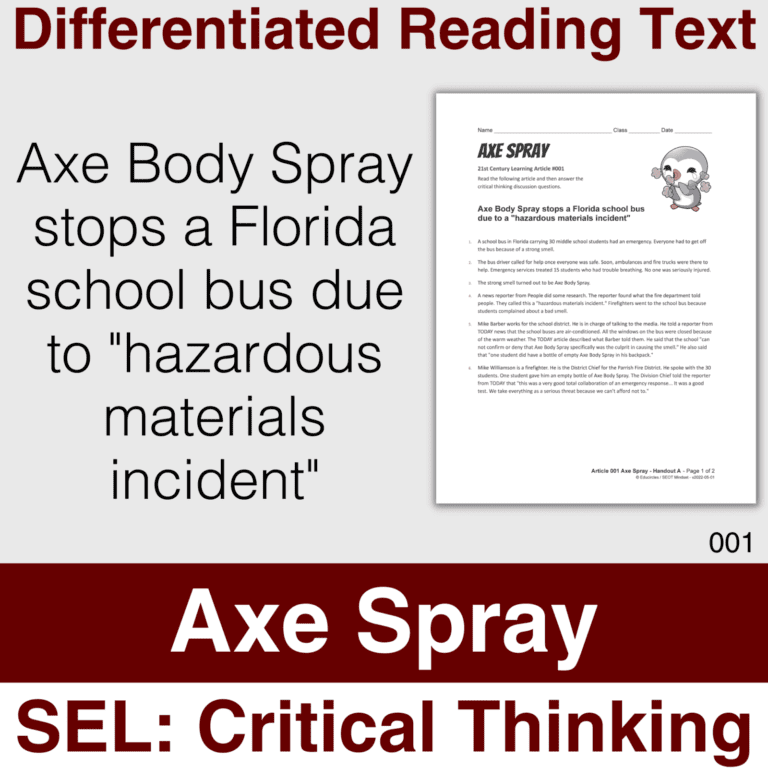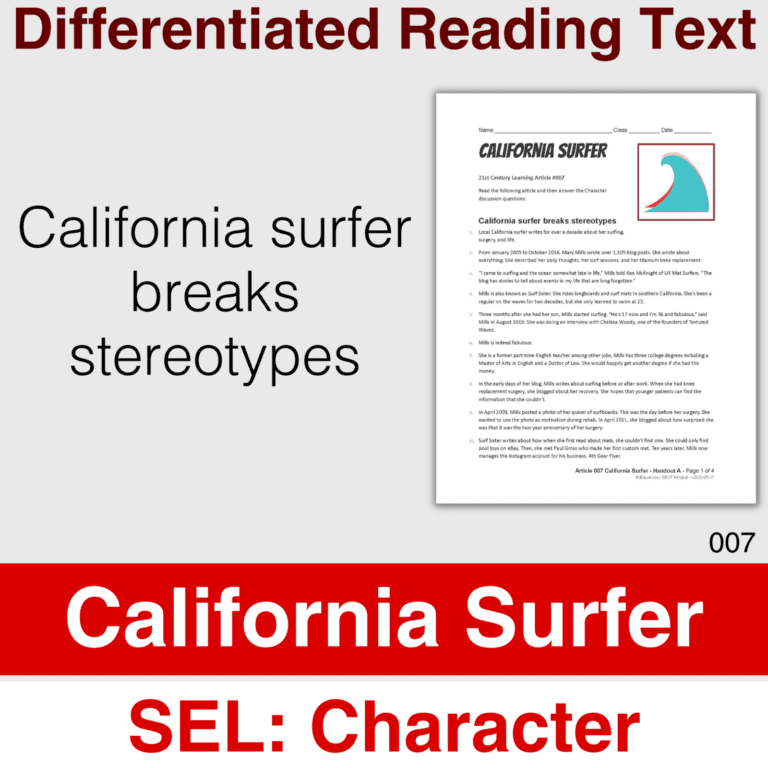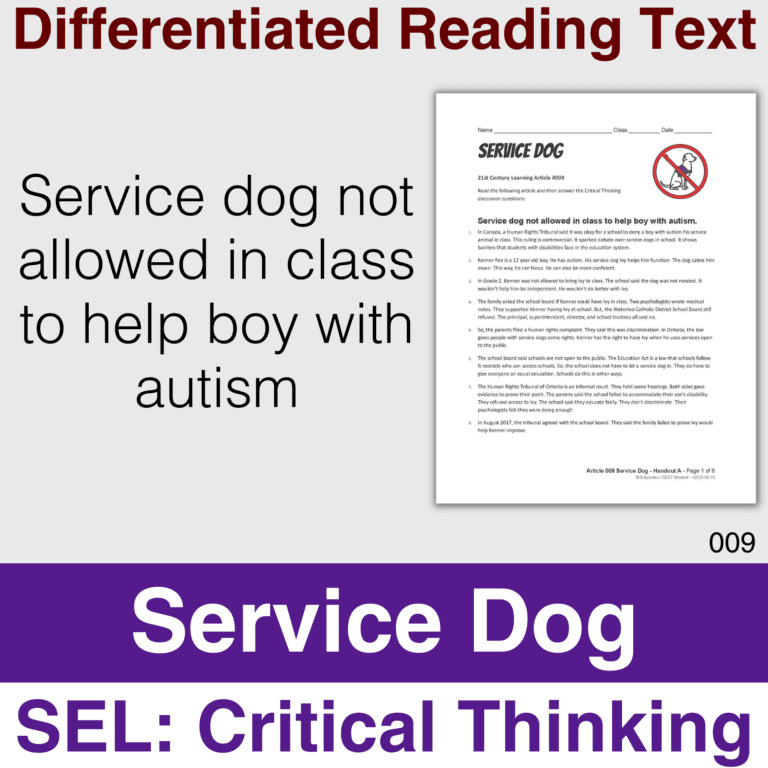Reading response article about CITIZENSHIP.
How can we discourage negative social media challenges like the Devious Licks TikTok challenge that destroyed school bathrooms in Sep 2021?
Reading comprehension article handout written at three different grade levels (Grades 6, 8, 10) with matching paragraph numbers. Includes sample answers.
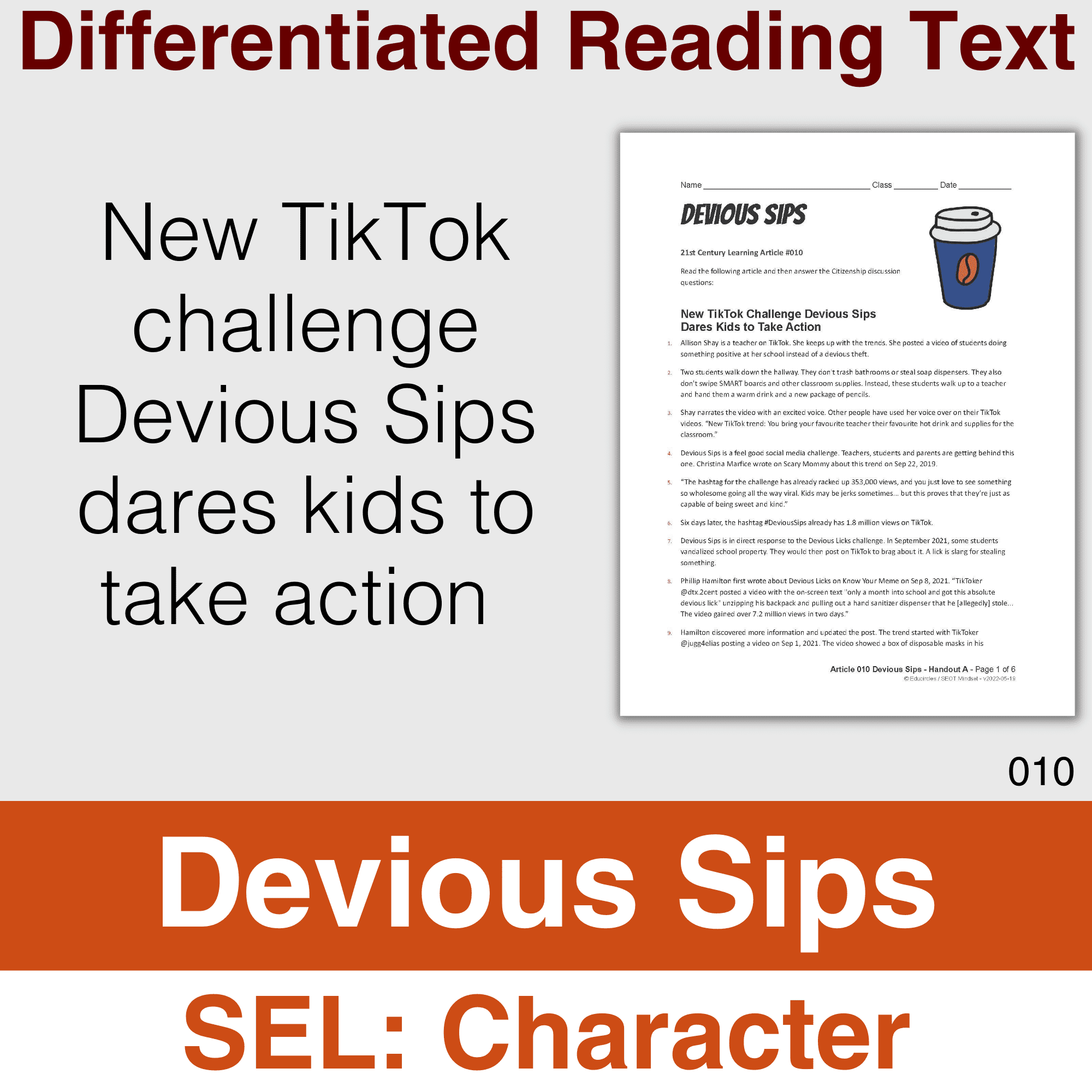
Want to see exactly what you get before you buy this product?
- Watch the PREVIEW VIDEO
- Look at the PREVIEW PDF.
(It is a watermarked version of the entire PDF resource.)
This article goes well with the MAKING CONNECTIONS reading strategy.
New TikTok Challenge Devious Sips Dares Kids to Take Action!
Ten discussion questions help students analyze and evaluate different responses to Devious Licks, including:
- positive social media challenges,
- arresting students, and
- reporting videos to shut down social media accounts.
(If you can’t post a video, it can’t go viral…)
Devious Sips and Devious Licks are really lessons in active citizenship.
- What do we do to encourage positive behaviors and challenge negative ones?
- How is responding to racism similar or different from responding to Devious Licks?
New TikTok Challenge Devious Sips Dares Kids to Take Action
Allison Shay is a teacher on TikTok. She keeps up with the trends. She posted a video of students doing something positive at her school instead of a devious theft.
Two students walk down the hallway. They don’t trash bathrooms or steal soap dispensers. They also don’t swipe SMART boards and other classroom supplies. Instead, these students walk up to a teacher and hand them a warm drink and a new package of pencils.
Shay narrates the video with an excited voice. Other people have used her voice over on their TikTok videos. “New TikTok trend: You bring your favourite teacher their favourite hot drink and supplies for the classroom.”
Devious Sips is a feel good social media challenge. Teachers, students and parents are getting behind this one. Christina Marfice wrote on Scary Mommy about this trend on Sep 22, 2019.
“The hashtag for the challenge has already racked up 353,000 views, and you just love to see something so wholesome going all the way viral. Kids may be jerks sometimes… but this proves that they’re just as capable of being sweet and kind.”
Six days later, the hashtag #DeviousSips already has 1.8 million views on TikTok.
Devious Sips is in direct response to the Devious Licks challenge. In September 2021, some students vandalized school property. They would then post on TikTok to brag about it. A lick is slang for stealing something.
Phillip Hamilton first wrote about Devious Licks on Know Your Meme on Sep 8, 2021. “TikToker @dtx.2cent posted a video with the on-screen text “only a month into school and got this absolute devious lick” unzipping his backpack and pulling out a hand sanitizer dispenser that he [allegedly] stole… The video gained over 7.2 million views in two days.”
Hamilton discovered more information and updated the post. The trend started with TikToker @jugg4elias posting a video on Sep 1, 2021. The video showed a box of disposable masks in his backpack. The caption called it an “absolutely devious lick.” This original TikTok video that started the craze gained 239,000 views within a week.
Devious Lick affected many middle schools and high schools. Principals closed bathrooms. Officers arrested students and laid felony charges. News stations ran stories.
If you like this content, you should definitely check out the reading comprehension strategies PDF bundle.
Rob Dirienzo reported on Fox 5 Atlanta on Sep 20, 2021. Two middle school students were charged. The students destroyed a school bathroom and filmed the whole thing. “Authorities just arrested two kids at Evans Middle School in the county after a staff member noticed the soap dispenser in the bathroom was ripped off the wall and missing.”
Lt. Greg Vansant from the Newnan Police Department spoke with Fox 5 Atlanta News. “Those soap dispensers… or windows or anything like that are government property and any defacing or vandalizing of that property is a felony.”
Devious Licks can be disruptive, criminal and trending. But, like any internet fad, it will go away. A new challenge will replace Devious Licks. It looks like in October, the TikTok challenge is to slap a teacher, run away, and post the deed on TikTok.
Of course, there are many ways to try to stop Devious Licks. We can encourage students not to get involved. Or we can educate parents and students about the potential consequences. Students who commit Devious Licks that get into trouble might act as a warning to others.
There is also a simple action that we can all do. This action doesn’t get discussed as often. We can report the video and the user on the social media platform. We can try to get the website to take down the video and close the user account.
Reporting a video or user is not the same as leaving a comment or posting your own response video. Ironically, those actions might have the opposite result. Commenting show controversy. This can lead to more attention.
Sometimes, people ask others to stop watching, liking, sharing or commenting on videos. This may not stop viral trends. Some people love watching the poor choices people make. Just as much as they love watching funny cat videos.
TikTok uses an algorithm to figure out which videos to show you. Choosing “not interested” only tells TikTok not to show this type of video to you. It is not a video take down request. But, clicking the “report” button can lead to the removal of the video.
Real people review the videos reported by people. These moderators decide if a video breaks the rules or not. TikTok can close the accounts of people who break the rules many times.
Once someone clicks the “report” button, the app lists several reasons. This includes “illegal activities and regulated goods”. When a person selects that option, a new menu appears with more options. Some Devious Lick videos show the destruction of school property or theft. TikTok can remove these videos under the “promotion of criminal activities” option.
The app will then say that they prohibit “content that depicts or promotes criminal activities.” After sending a report, TikTok thanks the user. They will “review your report and take action if there is a violation of our community guidelines.”
At this point, there is an option to view the status of other videos you have reported. TikTok shows a message in the inbox. It will say that you anonymously reported the video. At first, the status will be “under review.” If TikTok agrees with the complaint, the website will take down the video.
Can a person repost a video that was taken down? Absolutely. Can they create another account? Definitely. Can they post the video on a different social media channel? One hundred percent. Can they post a video with a variation of a hashtag that has been shut down? Certainly.
But, that shouldn’t stop people from reporting videos and users. Making a community safer requires active citizenship. This is an on-going process. It’s not a simple one-time action.
We are part of many communities. We belong to our classroom community, our school community, and our online communities. Citizenship is more than simply having a passport. It’s more than being a citizen of a place. It’s about being part of that community.
Active citizenship is not about everyone agreeing. We don’t have to all get along. In fact, hard conversations about controversial issues are important. They bring attention to groups of people that are treated poorly. Disagreeing about things can lead to change. This might help make things more fair.
TikTok is like any other social platform. They have a Terms of Service. You must agree to this document if you want an account. This gives them the legal right to “disable your user account at any time.” It also gives TikTok the right (but not the obligation) to take action. They can use their “sole discretion to remove, disallow, block or delete any User Content” that they consider violates their policies. The website can do this “in response to complaints from other users.”
Of course, TikTok will not delete a video simply because people disagree with it and report it. Their community guidelines explain what can and cannot be posted on TikTok. Reporting illegal activities on TikTok might be one way to slow down viral trends like Devious Licks.
Some people on the internet don’t care about trending on social media. But, many people post because they want the likes. They want lots of followers. So what happens when people lose this audience? Would people destroy school property if they knew they would lose their account?
TikTok deleted the Devious Licks videos from @jugg4elias and @dtx.2cent. They also shut down their accounts. These two TikTokers lost all any followers they gained because of their viral videos. They wasted any effort they put into gaining followers before their devious theft.
Devious Sips and Devious Licks are lessons in active citizenship. What do we do as a group of people to encourage positive behaviours and challenge negative ones?
Teachers, when you purchase this resource, you get this article in PDF, Google Doc, and Microsoft Word format differentiated at multiple reading levels. Otherwise, if you just copy / paste this content into a document, you’ll have to search for this paragraph so it doesn’t distract your students.
In October 2020, The New York Times ran an article about how to be an active bystander. The article focused on casual racism. There are similarities between dealing with racism and dealing with negative social media trends.
The article cites Monica Reyna. Reyna is a violence prevention educator at the Advocates. “Active bystanders see something bad happen and make discrete choices to respond to the concerning behavior.”
Reyna gave examples about what active bystanders can do when they see acts of racism. Active bystanders can record suspected police brutality. They can also challenge racist comments made during dinner conversations. Active bystanders might use humour to point out how a “compliment” might actually be racist. The idea of taking action when we see something bad is important.
We often think that we should mind our business and not get involved. Beryl Domingo is an active bystander coordinator at Quabbin Mediation. She explains why this shouldn’t be the case.
“When you don’t do something, the person doing the harm assumes that you’re in agreement with their actions… If we don’t challenge them, they will continue to do what they do and they will influence other people to do the same.”
Domingo talks about building “moral courage” to become a more active bystander. Her lessons about dealing with racism work well in many situations.
Many students won’t take part in negative social media challenges. But a few students do these negative actions because they want a little bit of social media fame. What if we took away that incentive by shutting down their videos and accounts?
How can we be active citizens when we see negative social media challenges? Do we report an illegal video to TikTok? Should we take part in feel-good challenges like Devious Sips? Or should we choose to be an active bystander in a different way? The real question is how can we respond in a way that helps make the world a better place?
Reading Comprehension Questions
Based on the article and the ideas about active citizenship in the article, how would you answer the following questions:
- What is the Devious Sips challenge? What is the Devious Licks challenge?
- How are closing bathrooms, suspending students, or arresting students similar? How are these approaches different? Which approach might be the most effective in stopping Devious Licks at a school?
- Why do some videos go viral but not others? What might stop a video from going viral?
- What would it take for the Devious Sips challenge to go viral? How could you contribute to that? Sometimes there are unintended consequences to our actions. What might be a downside to the Devious Sips challenge?
- The article suggests reporting videos to TikTok in an effort to discourage Devious Licks at a school. Why might reporting videos shut down the trend at a school? Why might this approach fail?
- How might dealing with Devious Licks be similar to dealing with racism? How might dealing with Devious Licks be different from dealing with racism?
- What lessons can we learn from dealing with Devious Licks that might help us to discourage racism? What lessons can we learn from dealing with racism that might help us to discourage Devious Licks?
- What do you think is the most effective response to the Devious Licks challenge? Explain your thinking.
- Create another option to discourage Devious Licks at a school. Why might this option work well? What might be some of the unintended consequences of this approach?


